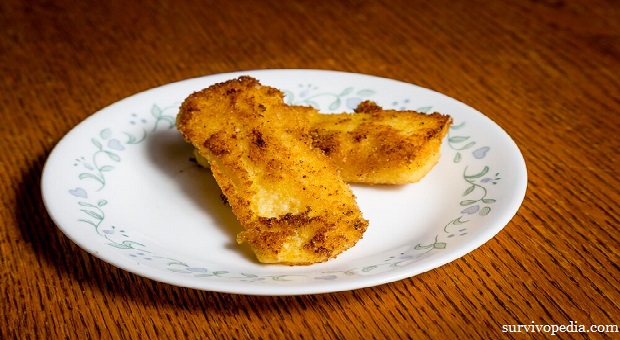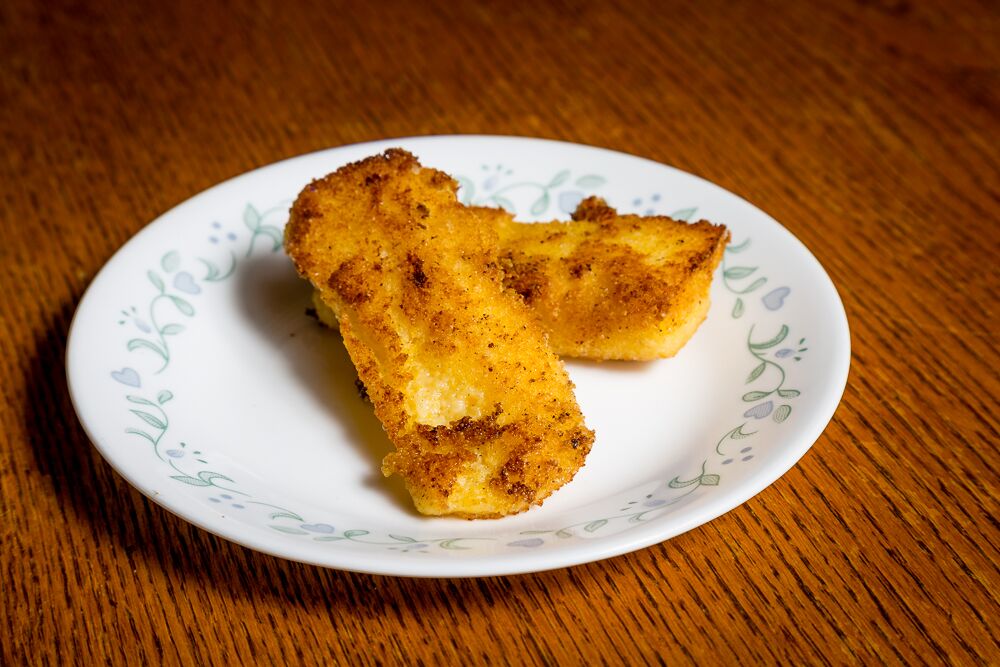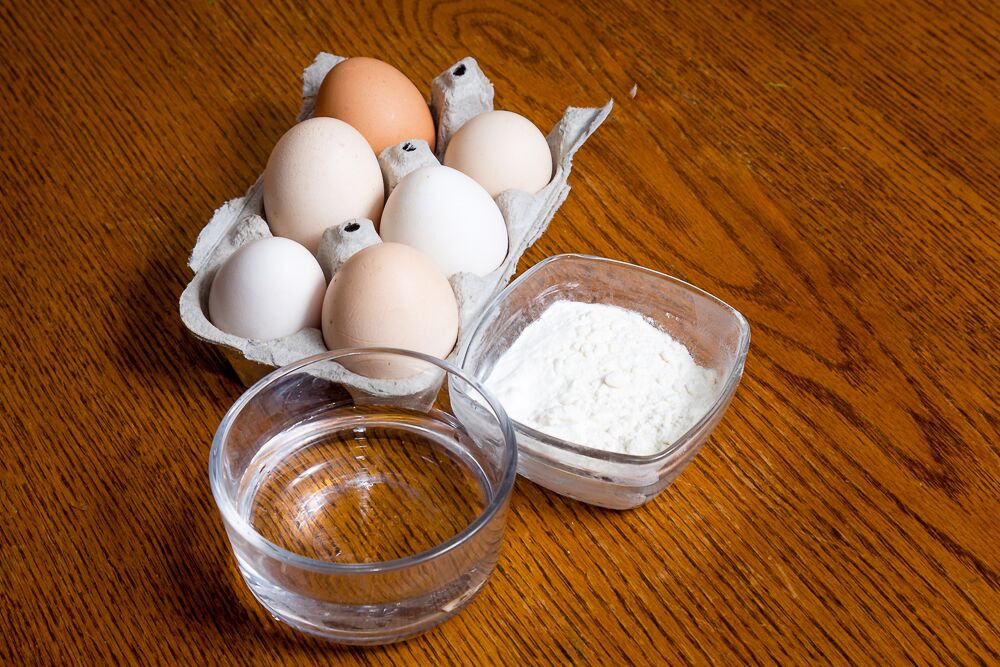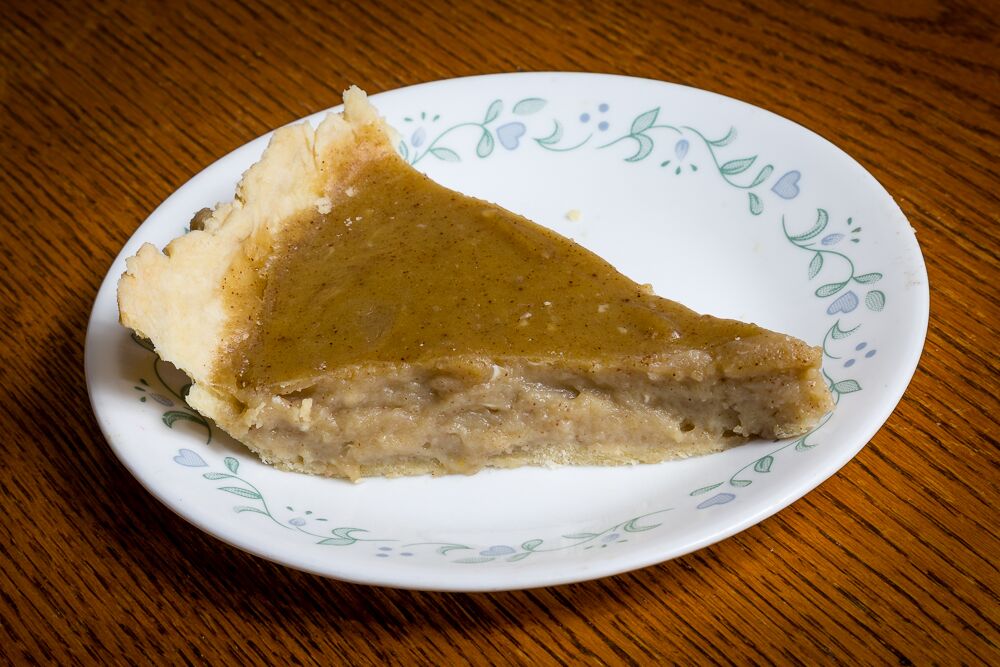During the Great Depression, cooks scraped meals together from whatever was available. By mixing bits of food with a little creativity and ingenuity, women across the country kept their families fed and alive.
Meals were simple, made from staple ingredients and whatever the family could grow, forage, or hunt. Many of these meals endured the test of time and got passed down from one generation to the next as a frugal way to feed the family.
Here are 15 recipes from the Great Depression you should learn to prepare. By adding them into your meal plan rotation now, you’ll help reduce the grocery budget. You’ll also have a stockpile of recipes using basic supplies you can prepare when disaster strikes, and you can’t get to the grocery store like you normally do.
1. Potato Pancakes
Potatoes stored well and were inexpensive, making them a staple. These potato pancakes use leftover mashed potatoes, helping families avoid waste.
Ingredients:
- 2 cups leftover mashed potatoes
- 1 egg
- ¼ cup flour
- Salt and pepper to taste
- 2-3 TBS bacon grease or oil for frying
Mix all ingredients except the oil in a bowl. Heat the grease in a skillet until hot. Carefully add heaping tablespoons of potato mixture to the hot oil.
Push batter down with a spatula. Cook for a few minutes, until browned, and flip. Brown the other side and remove from heat.
Serve with syrup, applesauce, or leftover gravy.
2. Fried Cornmeal Mush
Known for its versatility, you can enjoy items made with cornmeal for any meal. Fried cornmeal mush was common on the breakfast table during the depression.
Ingredients:
- 1 cup cornmeal
- 1 tsp salt
- 4 cups water (divided)
- Small amount of oil, butter, or lard for frying
Boil 3 cups of water in a kettle. In a bowl, whisk the cornmeal, salt, and remaining cup of water together. Mix until smooth.
Slowly add the cornmeal mixture to the boiling water, stirring to avoid lumps. Bring back to a boil, stirring constantly.
Reduce heat, cover, and simmer for 20 minutes. Stir several times while simmering.
Remove the pan from the heat and pour the hot cornmeal mush into a greased loaf pan. Cool overnight in the fridge.
Remove from pan and slice into slices (about 3/8 of an inch each).
Heat skillet with a small amount of oil, butter, or lard on the bottom. Fry the slices until golden-brown on each side.
Serve plain or topped with butter and syrup. You can also try it with ketchup.
©survivopedia.com
3. Rice Pudding
Here’s a great recipe to use up leftover rice.
Ingredients:
- ¼ to ½ bowlful of cooked rice, warm
- Milk to taste
- A small dab of butter
- A bit of sugar or honey to taste
Combine all ingredients. Add milk until the mixture is the consistency you enjoy.
4. Ham Hocks & Beans
You can let a pot of this simmer most of the day for a delicious, inexpensive meal. The beans don’t need presoaked when prepared this way.
Ingredients:
- 1-pound dry pinto beans
- 3-4 ham hocks
- Chopped onion
- Pepper
Rinse your beans and sort out any bad ones.
Place the beans, ham hocks, onion, and pepper in a large pot and cover with water. Bring to a boil.
Reduce heat, to keep beans simmering. Cover.
Let simmer for several hours, stirring and checking on it as it cooks. Add more water if needed, just enough to cover the beans.
It is ready when the beans are tender and the sauce around them thickens a bit. Remove the ham hocks and get any meat off the bones. Stir meat into beans and serve.
5. Chipped Beef over Toast
Also known as s**t on a shingle, this meal is filling and simple. If you don’t have dried beef, substitute ground venison, hamburger, or any other available meat.
Ingredients:
- 2 TBS butter
- 2 TBS flour
- 1 ½ cups milk
- 8 ounces dried meat (typically canned, chipped beef)
- 6 slices of bread, toasted
- Salt and pepper to taste
Melt the butter in a pan over medium heat. Whisk in the flour, creating a roux. Slowly mix in the milk and stir until it boils and gets thick.
Add in the meat and cook until heated.
Place a toast on each plate. Scoop gravy over the top of each.
6. Creamed Peas over Mashed Potatoes
Here’s a filling meatless meal using potato water instead of milk in the gravy. This water has many uses and is nutritious. Make sure to save it each time you boil potatoes.
Ingredients:
- 2 TBS butter
- 2 TBS flour
- 2 cups potato water (water you boiled potatoes in)
- Mashed potatoes
- 2 cups peas – frozen, fresh, or canned
- Salt and pepper
Melt butter in a saucepan. Whisk in flour until smooth, making a roux. Slowly add in potato water, whisking constantly to avoid lumps.
Bring to a boil, stirring constantly. Reduce heat and simmer until thick. Stir in peas, salt, and pepper.
Serve over hot mashed potatoes.
7. Simple Fish Chowder
During the depression, many people fished regularly. The fish they caught varied based on their location, but they ate them all. Here’s a simple chowder you can use your fish in. It uses evaporated milk instead of fresh, making it pantry friendly.
Ingredients:
- 1 large onion, chopped
- ½ cup butter
- 6 cups water
- 6 cups potatoes, peeled and diced
- 2 pounds fish, deboned and cut into chunks
- 3 TBS lemon juice
- 2 cans evaporated milk (12 ounces each)
- 2 tsp salt
- 2 tsp pepper
Melt butter in a soup pot and sauté the onion. Add water and bring to a boil.
Carefully add the potatoes and cook until fork tender. Add fish and lemon juice.
Reduce heat and simmer for ten minutes.
Add evaporated milk, salt, and pepper. Heat through and serve.
If you want to learn more skills and attitudes from the old times, check out this link
8. Stretched Scrambled Eggs
Here’s a simple way to stretch eggs without sacrificing flavor.
Ingredients:
- 6 eggs, beaten
- ¼ cup flour
- 1/3 cup water
- Salt and pepper
Whisk together flour and water until smooth. Add eggs and mix well. Season with salt and pepper.
Scramble like normal, until done.
Serve with a slice of bread, or with fried potatoes.
©survivopedia.com
9. Garbage Soup
Garbage soup helped reduce waste during the Great Depression. Each batch was different, depending on what you ate during the week.
It’s a great strategy to help you get the most out of your food. There’s no real recipe per se. Here’s how it’s made.
Keep all your vegetable scraps and bones in a container in the fridge. At the end of each week, place the ingredients in a pot. Cover with water and stir in lots of salt and pepper.
Bring to a boil, skim off any foam, and let simmer for several hours.
Strain out bones before serving.
10. Foraged Salad
Take time to learn what wilds around you are edible, and where you can find some without pesticides. Foraging gives you nutritious food for free.
You can adjust the ingredients in this simple foraged salad based on what is available.
Gather a variety of the following wild edibles:
- Dandelions (greens and yellow flowers)
- Lamb’s quarter
- Shepherd’s Purse
- Clover
- Edible mushrooms
Clean them well and remove any dead or browned leaves.
Toss with a little vinegar and olive oil right before serving. Add salt and pepper to taste.
11. Simple Homemade Bread
An inexpensive filler item, you could find homemade bread on the table for nearly every meal during the depression. By baking a large batch like this each week, you’ll always have bread ready to slice.
Note: This is a basic recipe, using minimal ingredients. If butter and eggs are available, add in 1 egg and ½ cup butter with the water for more flavor.
Ingredients:
- 16 2/3 cup flour (5 pounds)
- 5 TBS yeast
- 6 tsp salt
- 5 cups warm water
Combine 10 cups flour, yeast, and salt. Add water and stir well with a wooden spoon.
Continue adding flour, a cup at a time, until dough is thick. When you can no longer stir, begin kneading. Knead the bread until smooth and no longer sticky.
Cover and let rise until doubled in bulk (about an hour).
Punch down dough and let rest for ten minutes.
Shape dough into seven loaves. Place into greased loaf pans, or onto greased cookie sheets. Let rise one hour.
Bake at 350 degrees for 30 minutes, or until browned.
12. Goulash
Tomatoes were an easy crop for people to grow and preserve. This easy recipe puts those tomatoes to good use. Feel free to substitute other meat for the hamburger.
Ingredients:
- ½ pound hamburger
- 1 large onion, diced
- 2 cups uncooked macaroni
- Lots of fresh tomatoes, peeled and diced
- Salt and pepper
Brown hamburger and onion. Add tomatoes and let the juice run out into the pan. You want enough juice to cover the macaroni, add more tomatoes if necessary.
Stir in macaroni. Continue cooking on medium high until the macaroni is tender. Season with salt and pepper.
13. Oil Pie Crust
Pie was a common dessert during the depression. You could use just a pinch of different ingredients and combine them into a tasty treat.
The crust is an important part of the pie. If butter and lard aren’t available, you can use oil to make a simple pie crust. Here’s the recipe for a no-roll single crust.
Ingredients:
- ¼ cup oil
- 1 cup flour
- ½ tsp salt
- ¼ cup cold water
Mix oil, flour, and salt in a bowl until combined. Stir in water until mixed completely. Add a little more water if it’s crumbly.
Place into an 8-inch pie pan and spread it out with your hands. Cover the bottom and sides. Bring any excess over the rim and push down with a fork.
14. Vinegar Pie
Since vinegar could be made at home, depression era cooks often had it in abundance. With just a few basic ingredients, they could whip together a tasty vinegar pie.
Some families topped it with a layer of meringue. But, surplus eggs weren’t always available. It tastes just as delicious without any topping.
Ingredients:
- 2 TBS butter
- ½ cup sugar
- 3 TBS flour
- 1 tsp cinnamon
- ½ tsp cloves
- 1 large egg
- 2 TBS vinegar
- 1 cup water
- 1 unbaked pie crust
Preheat oven to 350 degrees.
Combine sugar and butter in a saucepan with a fork. Mix in flour, cinnamon, and cloves. Stir in egg, vinegar, and water. Mix until smooth.
Heat over medium heat, stirring constantly until thick. Remove from heat.
Bake 8-inch unfilled pie crust for 4 minutes.
Pour filling into crust, and bake for another 10-15 minutes, until set.
©survivopedia.com
15. Sugar Cream Pie
If cream is available, this tasty pie is simple to mix up.
Ingredients:
- 2/4 cup sugar
- 1/3 cup flour
- 2 cups cream
- Unbaked pie crust
Preheat oven to 350 degrees. Mix sugar and flour thoroughly. Slowly whisk in cream. When completely combined, pour into pie crust.
Bake for 45-50 minutes, until filling is firm.
Surviving the Depression
These simple recipes kept people alive throughout the depression. But, it wasn’t just these recipes. It was innovation and the ability to use everything. Waste not, want not wasn’t just a cliché saying, it was life.
And this same attitude will help you survive whatever crisis you find yourself in.














































































I grew up on these recipes. To me, they are comfort food. The sugar creaM pIe can alSo be made With buttermilk, adding a little melted butter , an egg, and vaNilla. The necessity of making every scrap count teaches a deeper respect for food and the love that goes into making it enough. Thank you for doing what you caN to keep these traditions and this american hardiness alive.
Hi,
I love stories of survival and recipes from yester year.
Thank you ms. Lisa Tanner
Warm regards,
Ms. Helms
We had goulash a lot while I was growing up. If we didn’t have any tomatoes my mom would put in a can of TOMATO soup.
we had many of these when I was a child…and they were delicious! Thanks for sharing. 🙂
I have eaten every FOOD from this list except fish chowder and sugar cream pie. Mom lived through the depression and was very innovative with foods on hand.
I have continued making these same recipes with some minor adjustments. my kids still make ham hock and beans and goulash I’ve enjoyed reading your article. thanks
Dear lisa,
Thanks so much for the recipes — I remember growing up with several of them in the ’40’s and early ’50’s!
THis shtf certainly could become real. That is one of the main reasons tha we moved from upstate ny (where we grew up) to sw montana…..
Warm regards,
Peter
VineGar pie was one of my fathers Favorites. We alsO frequently has brown sugar pudding aNother depression dessert..tastey, cheap to make ane quiCk to fix. Thanks for the memories.
Thanks so much for the post.Much thanks again. Really Cool.
Thank you so much for these depression era recipes. What fun was it to read this list of recipes? I have no idea of how these grandparents did it? They were amazing. I am going to try a couple of these, just to see what they tasted like in the day, but I’m not sure the garbage soup is going to fly around here, This is going to prove an exciting taste experiment.
The depression affected their entire lives and mine were so very frugal. They never went on a diet; because they never overate. They used everything they had. They constructed the tools they needed.
My grandparents (on both sides of my family) owned a Diary farm and did not suffer as much as other’s, but they never threw away food, and mended and made all of the clothes for the children, grandchildren, and themselves. My Grandmother always laid a lovely table with the best tasting meals ever. They found a way to thrive and survive.
Growing up in the 50’s, our parents were products of the great depression and we used a number of these recipes at home. Still love mashed potato cakes with onion and eggs, as well as SOS and fried corn meal mush.
I grew up on all but the fish chowder. Mom made corn chowder with fresh corn cut off the cob, potatoes diced small. ONIons chopped, and milk or cream with salt to taste. Simmer TILL potatoes and onions are tender.
I raised my kids on all of these and homemade biscuits more often than the yeast bread. Mom made the yeast bread for the week,.. almost every Monday.
I still like beans but today I add a cut up onion, a whole jalapeno, and some cut up BACOn and cook it in a crockpot overnight. Then when tender season to my taste with a tiny bit of salt. I live above 6000 ft so beans are either cooked long and slow or in a pressure cooker.
It’s all still good eating.